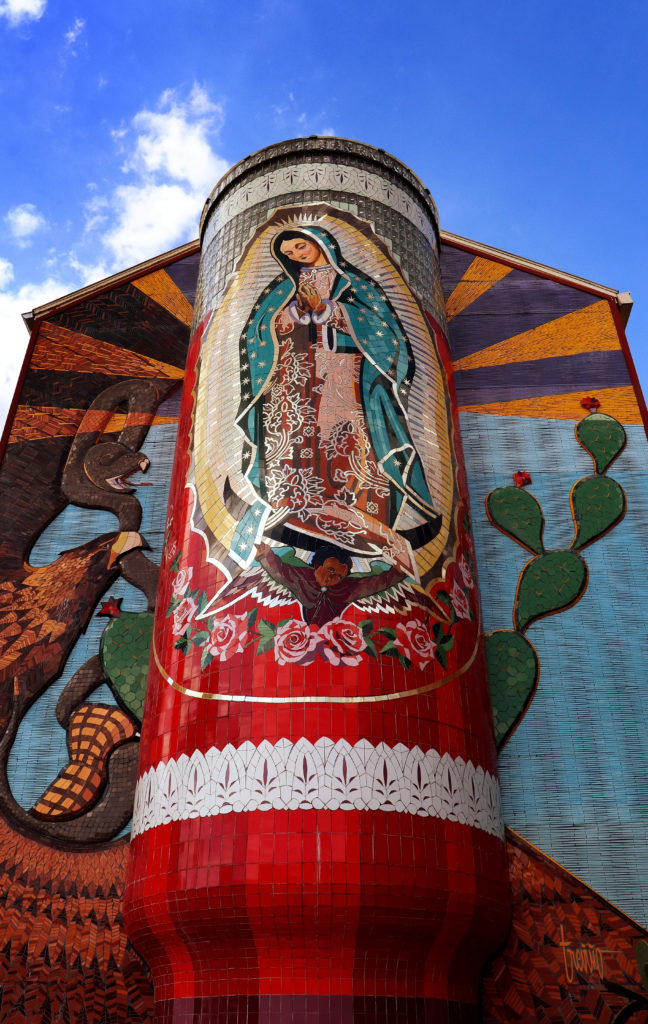World’s largest mosaic Virgin Mary statue watches over San Antonio’s West Side

Three little girls perched on a rock across from the makeshift stage while MidNite Flores stepped up to the microphone at the First Friday art festival at the Guadalupe Cultural Arts Center.
The 37-year-old pushed back the bright blue hair that fell into his face and started telling his story with cadence matching the rhythm of the drums behind him:
He came to San Antonio seven years ago. He landed on the streets with nowhere to turn. He saw a group painting. He asked to join in and found a new life through art.
His tiny fans cheered.
Flores is the youth coordinator for the San Anto Cultural Arts, spending his afternoons inspiring children through art. He and some of his students set up a tent at the festival on the first Friday of September, selling handcrafted goods and painting while music and aromas from a nearby taco truck filled the air.
On the other side of the art festival, “La Veladora of Our Lady of Guadalupe” — the world’s largest mosaic statue of the Virgin Mary — reigns from the side of The Guadalupe Cultural Arts Center watching over the neighborhood.
The artwork, crafted from vibrant red and gold tiles, has been a source of light and the center of the arts on the west side of San Antonio since it was completed in 2003 by Jesse Treviño, one of the city’s most notable artists.
People come from all over the country to visit La Veladora to pray and leave behind flowers and smaller versions of the giant candle structure. But Treviño didn’t craft the art for visitors. He built it for people like Flores in his hometown neighborhood.
*****
La Veladora is the epicenter of art on the West Side, with murals exploding around it in all directions, Flores said. The image of la Virgen de Gaudalupe is the symbol uniting their culture.
“If you go all around this neighborhood, you’ll notice that there’s tons of la Virgen de Guadalupe,” Flores said. “It’s part of the pride and culture.”
The West Side is a primarily Mexican-American neighborhood, said Gabriel Velasquez, executive director of Avenida Guadalupe Association, a community redevelopment corporation, but is also one of the poorest areas in the city. The poverty dates back to segregation when the first public housing was established in the neighborhood and led to generational poverty.
“With that neglect come all the predators of poverty,” Velazquez said. “So, the prostitutes, pimps, drug dealers, all of that.”
Violence on the streets had been ramping up in the 90s, when one day, Treviño was riding around the neighborhood and thought: It’s really dark. We need a Veladora.
Born in Monterrey, Mexico, Trevino, 73, moved to San Antonio when he was 4. He left for art school in New York City, but was drafted to the Vietnam War, where he lost his right arm. When he returned, he wanted to continue his art career in his hometown.
Last month, he updated La Veladora, repairing mosaic tiles and painting a new face on la Virgen de Guadalupe.
“I love being there with the locals and being a part of everything,” Trevilo said. “I feel really connected because I’m painting the issues within them.”
*****
Mark Riojas, theatre and production manager at the Guadalupe Cultural Arts Center, said the area was considered a slum in the 1950s, and the problems with drugs and crime continued. The Arts Center along with the Avenida Guadalupe Association pushed to get the community active.
The creation of La Veladora was one of the first steps.
The Arts Center hosts events like the First Friday festival to provide opportunities for economic and community development by uniting the community through free family-friendly events.
“The bad stuff hasn’t all gone away,” Riojas said. “But it’s just a little easier to walk around.”
Alejandra Gutierrez, 29, hung around the San Anto tent at the festival, as her two daughters weaved around the tables with all the other kids selling their artwork. She said the Veladora and the arts have been a beacon through the violence and homelessness in her neighborhood.
“It’s always light,” Gutierrez said. “We gather around it as a community and as a family. It’s always been that way, and it will always be that way.”
Gutierrez explained that her relationship with La Veladora is different. She’s a First Nations people in San Antonio, so she doesn’t call the figure “La Virgen de Guadalupe;” instead she calls her “Madre Tonantzin” — the mother of the earth.
“She is connected to every single one of us,” Gutierrez said. “She is the one that brings the hope and she is the one that brings the unity.”
At the festival, Gutierrez made her way to the stage to watch MidNite Flores perform his spoken word.
The poet’s hands danced as he told his story about how he found hope through the San Anto Cultural Arts and now passes that along to the 15 kids in his afterschool program.
Flores sat under his tent, the setting sun smiling as children ran up to him flaunting the dollar bills they earned from selling their art.
He watched over the kids with care — a block away La Veladora was doing the same.
Karina Elwood is a 2019 NAHJ Student Project participant. She is a junior at the University of Florida majoring in journalism. She is the features editor at the Independent Florida Alligator and spent her summer interning at the Orlando Sentinel justice and safety desk. Reach her at karina.elwood@ufl.edu and on Twitter at @Karina_Elwood.
When will the next scheduled festival be held? I would like to mark my calendar.